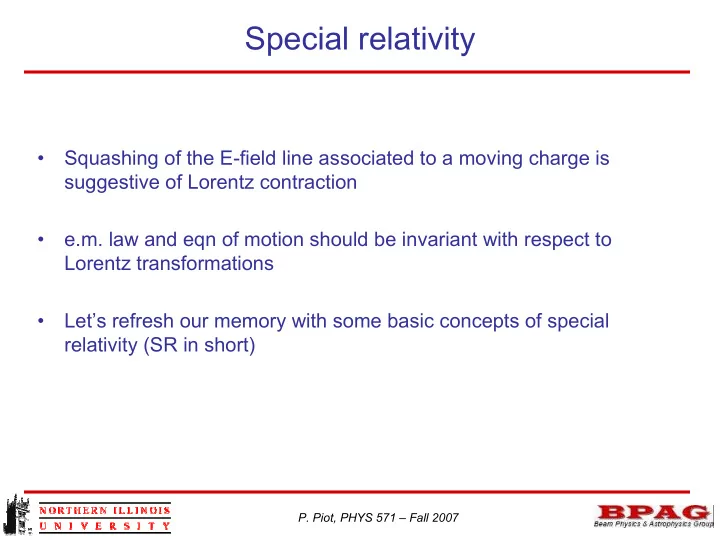

Special relativity • Squashing of the E-field line associated to a moving charge is suggestive of Lorentz contraction • e.m. law and eqn of motion should be invariant with respect to Lorentz transformations • Let’s refresh our memory with some basic concepts of special relativity (SR in short) P. Piot, PHYS 571 – Fall 2007
Proper time • Consider two spherical waves • So for photons we can write • This holds true for any inertial frames, and one generally define the proper time which is an invariant (it is a scalar) P. Piot, PHYS 571 – Fall 2007
Proper time • In SR proper time is an invariant. • Note that P. Piot, PHYS 571 – Fall 2007
Proper time • Proper time defined as • This holds true for any inertial frames, and one generally define the proper time which is an inva- riant (it is a scalar) P. Piot, PHYS 571 – Fall 2007
3+1 dimension space & Minkowski’s metric • Let • Then we can write contravariant with and is the Minkowski’s metric. P. Piot, PHYS 571 – Fall 2007
3+1 dimension space -- some properties • Some useful properties α αβ x = g x β contravariant covariant • The scalar product is defined as α α β αβ = = x . x g x x g x x α αβ α β • Contravariant and covariant form of the metric are equal αβ = g g g g γδ γα δβ mixed form is the Kroenecker delta function β αβ β = = δ g g g γ γα γ P. Piot, PHYS 571 – Fall 2007
Lorentz transformation (LT) I • Derived to in sure Laws of Physics have the same form in inertial frames • Many proofs … The transformation must let d τ invariant. A possible transformation is • = ϕ + ϕ x x ' cosh ct ' sinh = ϕ − ϕ ct x ' sinh ct ' cosh Consider the coordinate in O O corresponding to the origin ( x’=0 ) in O’ O’ = ϕ ϕ = γβ x ct ' sinh sinh x ⇒ ⇒ ϕ = Vt = β tanh = ϕ ϕ = γ ct ct ' sinh cosh Rapidity (additive for LT compositions) • Which gives (in 1+1 dim) the usual Lorentz transform (LT). • If e.m. only is considered other transformation can let Maxwell’s equation invariant (e.g. just dilations) but LT are universal. P. Piot, PHYS 571 – Fall 2007
Lorentz transformation II • The Lorentz transform from O to O ’ (two aligned inertial frames) is given by the boost matrix [see JDJ eqn (11.98)] • Note that • The Lorentz transformation is • Formally If O and O ’ not aligned Lorentz transformation would be Λ α • β multiplied by a rotation matrix P. Piot, PHYS 571 – Fall 2007
Particle dynamics in SR • The principle of SR is : The principle of SR is : • –All laws of physics must be invariant under Lorentz transformations. –“ Invariant ” ⇔ Physics laws retain the same mathematical forms and numerical constants (scalars) keep the same value. P. Piot, PHYS 571 – Fall 2007
Particle dynamics in SR: 4- velocity • define • Then • An invariant can be form via the scalar product Moreover since d τ is an invariant and then • u conforms to Lorentz transformation i.e. satisfies the principle of SR! P. Piot, PHYS 571 – Fall 2007
Particle dynamics in SR: 4- momentum • Define • Then and • The fundamental dynamical law for particle interactions in SR is that 4-momentum is conserved in any Lorentz frame. • So Kinetic energy ⇒ P. Piot, PHYS 571 – Fall 2007
Particle dynamics in SR: example • Consider w one incident n at rest Question : Minimum required energy for the incoming n to enable the Question reaction? Answer : At threshold the 4 final neutrons are at rest in the lab frame Answer with we finally get the threshold energy P. Piot, PHYS 571 – Fall 2007
Recommend
More recommend